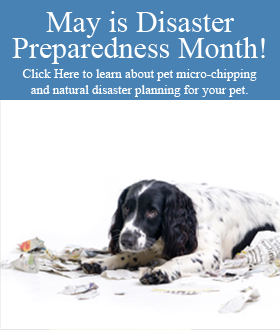Impala was a 3 year old female Dachshund, which was presented for a sudden onset of difficulty breathing. Impala had a litter of 6 puppies 2 weeks ago. She was not on heartworm prevention, but was up-to-date on vaccines. On presentation Impala was panting heavily, trembling, had a nice gum color, temperature of 102.5 degrees F, an elevated heart rate of 140 beats per minute. The mammary glands were enlarged. Only a couple of the glands had milk while the rest were bone dry.
Based on her history Impala was suspected of having a very low calcium level. Blood samples were obtained to confirm this. An oral calcium supplement was given as well as an injection in the muscle of Calcium. An IV catheter was placed and IV fluids were started. An injection of IV calcium was administered very slowly (over a five minute period of time). Within 5 minutes after giving the IV calcium injection, Impala was doing much better. She was not breathing as heavy as she was, no longer trembling and not in as much distressed. A few minutes later she ate the can food that was offered to her.
Upon questioning Impala’s owners, this was her second litter of puppies. In the first litter she had 4 puppies, and had not had problems at all. She was on a high quality puppy food. She had been fed the same food all of her life (for the past 3 years). She had started with the panting about 3 hours before being presented at the clinic. It was unknown if Impala had eaten that morning.
Impala’s lab results as follows:
- Calcium 4.36 mg/dl (normal 7.9-12.00 mg/dl)
- Glucose 135.0 mg/dl (normal 77.0-125.0)
This confirmed the diagnosis of hypocalcemia (lower than normal calcium level).
So how did Impala develop this low calcium when she was on a puppy food?
What had happened with Impala was her body was so use to the high calcium level in the puppy food that she was eating all of the time her body was not absorbing all of the calcium. Her body was absorbing what she needed and then excreted the rest through the feces and urine. Because she was constantly exposed to a high level of calcium in her diet her body was unable to pull calcium from the storage areas of her body (e.g. her bones). All of the calcium she had in her body was going into the milk production for the puppies, which they were readily depleteing. What could have been done to possibly prevent this was to only feed the puppy food no longer that 2 weeks before she had the puppies. The remainder of the time she should have been fed an adult dog food.
But food alone was not the only contributing factor to this problem. The fact that she had a large litter size was also a factor. She had to produce so much milk to nurse the puppies that her body could no handle it.
If Impala had not been brought in when she was she would have died. She would have gone into seizures, her brain would have swelled, and her muscles would have continued to contract.
Impala’s owners were instructed to hand-raise the puppies, by feeding a puppy milk replacer & not allowing them to nurse off of Impala. They were also instructed to provide calcium supplementation to Impala as long as she was producing milk. Once the puppies were weaned they were instructed to put Impala on adult dog food.
The hypocalcemia that Impala experienced could have happened even before she had the puppies. Although this condition most commonly occurs 1-4 weeks after whelping. It also usually affects small breed dogs. Once this happens it can occur again in subsequent litters.
When Impala went home her calcium level was normal at 10.14 mg/dl. Currently Impala & puppies are doing well.
(This was an actual case history from a local veterinary clinic actively affiliated with the Hillsborough Animal Health Foundation.)





































